“I use nontraditional materials to weave traditional Onondaga and Micmac basketry forms that comment on Indigenous life in the twenty-first century. I began making “film” baskets in 1985 when I was teaching film theory with filmmaker Marge Brown at Evergreen State College. She suggested that I do a film project. I asked our students for out-takes from their projects and wove my first film basket, which I presented to Marge at the end of the quarter. Film was an interesting material, and I enjoyed the notion of recycling it and gaining control over a medium historically used by both Hollywood and documentary filmmakers to stereotype American Indians. I relished the irony of making film take on the traditional fancy stitch patterns of our ash-splint and sweetgrass baskets. I developed complex patterns and began to use leader as well as exposed film. I also began to use recycled footage from films being thrown away by libraries, which allowed me to choose certain images that suited my themes. I enjoy creating titles to contextualize these baskets and often choose materials to ironic purpose. The choice of weaving stitches, many of which have names, is also deliberate.
The “film” basket that I created for Changing Hands, 3-It Was Never About Playing Cowboys and Indians-was made from a documentary titled Play and Cultural Continuity, Part VI: Montana Indian Children. The content of the film focuses on various kinds of play: girls learning to put their dolls in cradle boards, children learning to do beadwork, and other activities that maintain Indian culture. I chose a porcupine-point stitch in red and blue at the bottom of the basket to refer to the prickly nature of Indian-White relations in America, where, for generations, non-Indian children have played cowboys and Indians. I chose to use red ribbon stitch at the top to praise Indian children for playing games that help them to preserve their culture.”
Gail Tremblay
Biographical Statement
Gail Tremblay is a descendant of Onondaga and Micmac ancestors. She resides in Olympia, WA and has been an artist, writer, and cultural critic for over thirty years. She shares a unique vision through her multi-media visual works, art installations, her writing on Native American Art, and her poetry. She is a professor at The Evergreen State College, where she has mentored students in the fields of visual arts, writing, Native American and cultural studies. She has served the larger artistic community as a member and president of the National Board of the Women’s Caucus for Art, and received a national “Mid-Career Art Award” from that organization in 1993. She has also received a Governor’s Art Award in the state of Washington for her Contemporary Art in 2001. Her influence has been felt on the international level through her two trips to China as part of women’s artists’ delegations, and her exhibitions in Switzerland in 1985, in China in 1995, in Mexico in 1998, the Czech Republic in 2000, Belo Horizonte, Brazil in 2005 and Germany in 2013-14. Her visual art has been featured in over 100 group and solo exhibits throughout the nation and is in the collections of the Department of the Interior, the National Museum of the American Indian, The Portland Art Museum, The Denver Art Museum, the Renwick Gallery/Smithsonian American Art Museum, the Brooklyn Art Museum, the Hallie Ford Museum of Art, The Whatcom Art Museum, the Missoula Art Museum and the Microsoft Corporation Collection among others. Her writing and information about her art has been published in more than 50 different books, journals, and periodicals, and she has been in great demand as a lecturer and workshop presenter. She has worked for over thirty years to assure that issues of diversity and gender equity are addressed in the teaching of art, in the writing of art criticism and art history, in the curating of exhibits, and in the granting of public and private funding to artists and art institutions. Her book of poems, Indian Singing is published by Calyx Press, and her last book of poems, Farther from and Too Close to Home was published by Lone Willow Press. Her poetry is widely anthologized and poems have been translated into French, German, Spanish, and Japanese and published internationally.
“Film” Baskets
 When Will the Red Leader Overshadow Images of the 19th Century Noble Savage in Hollywood Films that Some Think are Sympathetic to American Indians, 2018
When Will the Red Leader Overshadow Images of the 19th Century Noble Savage in Hollywood Films that Some Think are Sympathetic to American Indians, 2018
35mm film, red and white leader, silver braid
15 1/2 x 14 x 14 in
39.4 x 35.6 x 35.6 cm
Tremblay used metallic thread, red and white film leader, and 35mm film from the 1981 film “Windwalker’ to construct this basket. In the Collection of the Renwick Gallery/American Art Museum
 If the Ice Melts and the Grass Grows on Small Islands in the Sea, Will Images of the Inuit World Become Fragments Lost in History, woven in 2018
If the Ice Melts and the Grass Grows on Small Islands in the Sea, Will Images of the Inuit World Become Fragments Lost in History, woven in 2018
16mm film, green, blue and white leader, silver and gold braid
24 x 13 1/2 x 13 1/2 in
61 x 34.3 x 34.3 cm
Basket is woven with 16mm film from “At the Winter Sea Ice Camp, Part 2′ filmed in 1967, in addition to smaller 8mm film
Since High School My Most Wanted Has Been to See Roles for Red Leaders among the Images of Blacks and Whites on the Silver Screen 2009. In the Collection of the Portland Art Museum, Portland, OR
 An Iroquois Iroquois Dreams that the Tribes in the Middle East Will Take the Message of Deganawida to Heart and Make Peace, recycled 16 mm films (“Israel” and Arab Identity”) red, white and blue leader. metallic yarn and braid, Size 24” high X 13.5 in diameter, 2009. In the Collection of the Whatcom Museum, Bellingham,WA
An Iroquois Iroquois Dreams that the Tribes in the Middle East Will Take the Message of Deganawida to Heart and Make Peace, recycled 16 mm films (“Israel” and Arab Identity”) red, white and blue leader. metallic yarn and braid, Size 24” high X 13.5 in diameter, 2009. In the Collection of the Whatcom Museum, Bellingham,WA
 It was Never about Playing Cowboys and Indians, Materials: Recycled 16 mm film (Play and Cultural Continuity: Montana Indian Children) red, white and blue film leader, and metallic braid, woven in porcupine and ribbon stitch, Size 24” high x 13.5 in Diameter. 2012.In the Collection of the Denver Art Museum.
It was Never about Playing Cowboys and Indians, Materials: Recycled 16 mm film (Play and Cultural Continuity: Montana Indian Children) red, white and blue film leader, and metallic braid, woven in porcupine and ribbon stitch, Size 24” high x 13.5 in Diameter. 2012.In the Collection of the Denver Art Museum.
Video: Gail Tremblay: Changing Hands: Art Without Reservation 3 – Museum of Arts and Design, New York


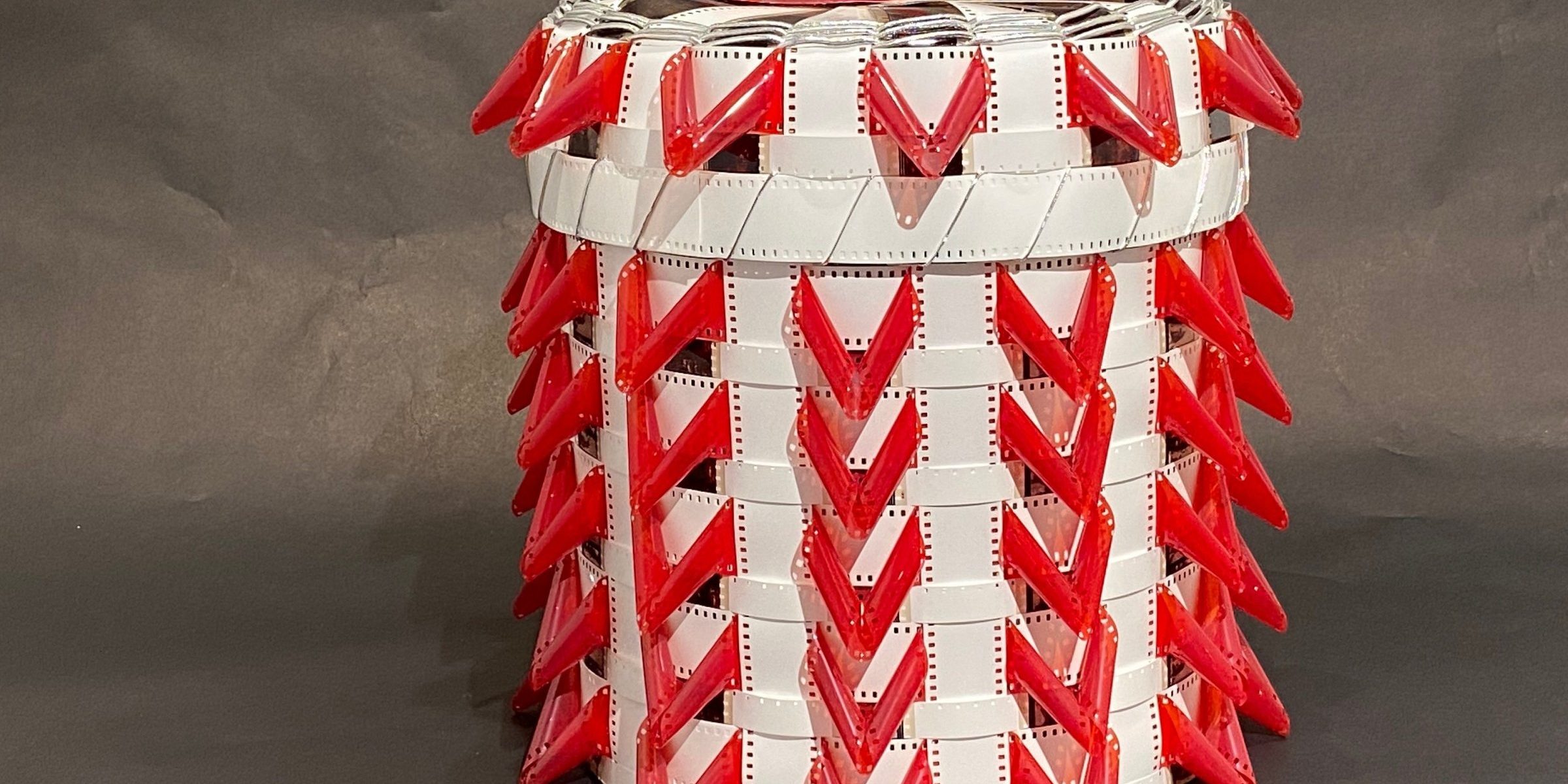
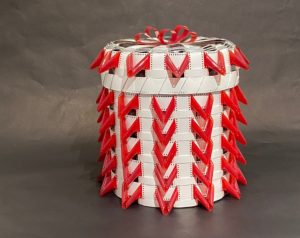 When Will the Red Leader Overshadow Images of the 19th Century Noble Savage in Hollywood Films that Some Think are Sympathetic to American Indians, 2018
When Will the Red Leader Overshadow Images of the 19th Century Noble Savage in Hollywood Films that Some Think are Sympathetic to American Indians, 2018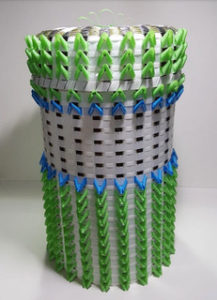 If the Ice Melts and the Grass Grows on Small Islands in the Sea, Will Images of the Inuit World Become Fragments Lost in History, woven in 2018
If the Ice Melts and the Grass Grows on Small Islands in the Sea, Will Images of the Inuit World Become Fragments Lost in History, woven in 2018
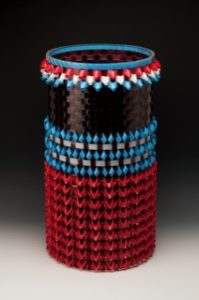 An Iroquois Iroquois Dreams that the Tribes in the Middle East Will Take the Message of Deganawida to Heart and Make Peace, recycled 16 mm films (“Israel” and Arab Identity”) red, white and blue leader. metallic yarn and braid, Size 24” high X 13.5 in diameter, 2009. In the Collection of the Whatcom Museum, Bellingham,WA
An Iroquois Iroquois Dreams that the Tribes in the Middle East Will Take the Message of Deganawida to Heart and Make Peace, recycled 16 mm films (“Israel” and Arab Identity”) red, white and blue leader. metallic yarn and braid, Size 24” high X 13.5 in diameter, 2009. In the Collection of the Whatcom Museum, Bellingham,WA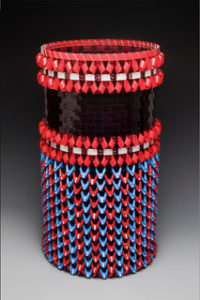 It was Never about Playing Cowboys and Indians, Materials: Recycled 16 mm film (Play and Cultural Continuity: Montana Indian Children) red, white and blue film leader, and metallic braid, woven in porcupine and ribbon stitch, Size 24” high x 13.5 in Diameter. 2012.In the Collection of the Denver Art Museum.
It was Never about Playing Cowboys and Indians, Materials: Recycled 16 mm film (Play and Cultural Continuity: Montana Indian Children) red, white and blue film leader, and metallic braid, woven in porcupine and ribbon stitch, Size 24” high x 13.5 in Diameter. 2012.In the Collection of the Denver Art Museum.



